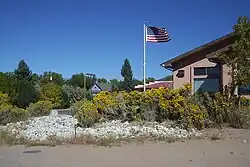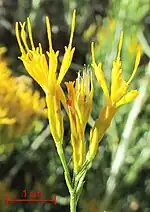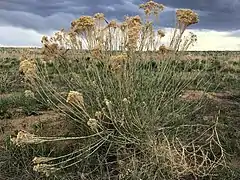| Ericameria nauseosa | |
|---|---|
 | |
| Ericameria nauseosa in Oregon | |
| Scientific classification | |
| Kingdom: | Plantae |
| Clade: | Tracheophytes |
| Clade: | Angiosperms |
| Clade: | Eudicots |
| Clade: | Asterids |
| Order: | Asterales |
| Family: | Asteraceae |
| Genus: | Ericameria |
| Species: | E. nauseosa |
| Binomial name | |
| Ericameria nauseosa | |
| Synonyms[1] | |
|
Synonymy
| |


Ericameria nauseosa (formerly Chrysothamnus nauseosus), commonly known as chamisa, rubber rabbitbrush, and gray rabbitbrush, is a shrub in the sunflower family (Aster) found in the arid regions of western North America.
Two subspecies have been described, consimilis (the green form with 8 varieties) and nauseosa (the gray form with 14 varieties).[2]
Description
Ericameria nauseosa is a perennial shrub growing to 2 to 8 metres (6+1⁄2 to 26 feet).[3] The leaves, depending on the subspecies, are 2–7.5 centimetres (3⁄4–3 inches) long[4] and narrow to spatula-shaped. Both the flexible (rubbery) stems and the leaves are greenish-gray with a soft felt-like covering.[5]
It blooms from August to October[6] and produces pungent-smelling, golden-yellow flowers. The flower heads are 6–13 millimetres (1⁄4–1⁄2 in) long[4] and made up of 5 small, yellow, tubular disk flowers, and occur in umbrella-shaped terminal clusters.[7][5] The shrub reproduces from seeds and root sprouts.[5]
Taxonomy
Rubber rabbitbrush was moved from the genus Chrysothamnus to the genus Ericameria in a 1993 paper.[2] The findings of a 2003 phylogenetic investigation of Ericameria were consistent with the move of the species to Ericameria.[8] The second edition of the Jepson plant manual[9] and the United States Department of Agriculture's Germplasm Resources Information Network[10] have adopted the name Ericameria nauseosa.
The specific epithet means 'heavy scented'.[11]
Subspecies and varieties
Recognized infraspecific taxa from The Plant List[1] with distribution information from Flora of North America[5] and Tropicos:[12]
- Ericameria nauseosa subsp. consimilis (Greene) G.L.Nesom & G.I.Baird (green form)
- Ericameria nauseosa var. arenaria (L.C.Anderson) G.L.Nesom & G.I.Baird – sandstone in Arizona, New Mexico, Utah
- Ericameria nauseosa var. arta (A.Nelson) G.L.Nesom & G.I.Baird – Idaho, Oregon
- Ericameria nauseosa var. ceruminosa (Durand & Hilg.) G.L.Nesom & G.I.Baird – gravelly arroyos in Mohave Desert of California
- Ericameria nauseosa var. juncea (Greene) G.L.Nesom & G.I.Baird – Utah
- Ericameria nauseosa var. leiosperma (A.Gray) G.L.Nesom & G.I.Baird – sandy + rocky sites in Arizona, California, Colorado, Nevada, Utah
- Ericameria nauseosa var. mohavensis (Greene) G.L.Nesom & G.I.Baird – scrublands in California, Nevada
- Ericameria nauseosa var. nitida (L.C.Anderson) G.L.Nesom & G.I.Baird – dry streambeds in Arizona, New Mexico, Utah
- Ericameria nauseosa var. turbinata (M.E.Jones) G.L.Nesom & G.I.Baird – sand dunes in Arizona, Nevada, Utah
- Ericameria nauseosa subsp. nauseosa (gray form)
- Ericameria nauseosa var. ammophila L.C.Anderson – Colorado[13]
- Ericameria nauseosa var. bernardina (H.M.Hall) G.L.Nesom & G.I.Baird – open pine forests in California; Baja California
- Ericameria nauseosa var. bigelovii (A.Gray) G.L.Nesom & G.I.Baird – dry slopes in Arizona, Colorado, New Mexico, Utah
- Ericameria nauseosa var. graveolens (Nutt.) Reveal & Schuyler – plains in Sask.; Arizona, Colorado, Idaho, Kansas, Montana, Nebraska, Nevada, New Mexico, Dakotas, Oklahoma, Texas, Utah, Wyoming
- Ericameria nauseosa var. hololeuca (A.Gray) G.L.Nesom & G.I.Baird – slopes in Arizona, California, Idaho, Nevada, New Mexico, Oregon, Utah
- Ericameria nauseosa var. iridis (L.C.Anderson) G.L.Nesom & G.I.Baird – steep, barren slopes in Sevier County in Utah
- Ericameria nauseosa var. latisquamea (A.Gray) G.L.Nesom & G.I.Baird - dry streambeds in Arizona, New Mexico; Baja California, Sonora
- Ericameria nauseosa var. nana (Cronquist) G.L.Nesom & G.I.Baird – ridges and cliffs in Idaho, Oregon, Washington
- Ericameria nauseosa var. nauseosa – plains + hills in Alberta, Saskatchewan; Colorado, Idaho, Montana, Nebraska, Dakotas., Wyoming
- Ericameria nauseosa var. oreophila (A.Nelson) G.L.Nesom & G.I.Baird – Arizona, California, Colorado, Idaho, Montana, Nevada, New Mexico, Oregon, Utah, Wyoming, Baja California
- Ericameria nauseosa var. psilocarpa (S.F.Blake) G.L.Nesom & G.I.Baird – sagebrush scrub in eastern Utah
- Ericameria nauseosa var. salicifolia (Rydb.) G.L.Nesom & G.I.Baird – brushlands in Utah
- Ericameria nauseosa var. speciosa (Nutt.) G.L.Nesom & G.I.Baird – brush + open woodlands in Alberta, British Columbia, California, Colorado, Idaho, Montana, Nevada, Oregon, Utah, Washington, Wyoming
- Ericameria nauseosa var. texensis (L.C.Anderson) G.L.Nesom & G.I.Baird – Guadalupe Mountains in Texas + New Mexico
- Ericameria nauseosa var. washoensis (L.C.Anderson) G.L.Nesom & G.I.Baird – open rocky sites in grasslands of northeastern California and northwestern Nevada
Distribution and habitat
It grows in the arid regions of western Canada, western United States (from the western Great Plains to the Pacific) and northern Mexico.[14]
Ecology
Along with associated species, like big sage and western wheat grass, rubber rabbitbrush is only lightly or occasionally used by herbivores during the summer. However, it can be heavily used during the winter when other food sources are scarce and on depleted rangelands.[15][16] Some of the species that consume it include mule deer, elk, pronghorns, and black-tailed jackrabbits. It is considered poor forage for almost all domestic animals, though sheep are reported to consume significant amounts of it in Utah.[15] It is also frequently used as shelter by jackrabbits.[17] Dense stands of this species often grow on poorly managed rangelands, in disturbed areas along roadways and on abandoned agricultural property.[16]
The species often occurs with Chrysothamnus viscidiflorus.[11]
Cultivation
Rabbitbrush, Ericameria nauseosa, has gained popularity as an ornamental xeriscaping shrub in areas where water conservation is important. It thrives in a wide range of coarse, alkaline soils that are common to desert environments. Pruning the shrub back to several inches in early spring, before new growth begins, may help improve the shrub's ornamental value.[18] The varieties Ericameria nauseosa var. nauseosa and Ericameria nauseosa var. speciosa are especially valued as they rarely exceed 24 inches and will often only reach a foot in height. Gardeners appreciate the enthusiastic late season blooms as well as the foliage.[17]
Radioactivity
Specimens growing in Bayo Canyon, near Los Alamos, New Mexico, exhibit a concentration of radioactive strontium-90 300,000 times higher than a normal plant. Their roots reach into a closed nuclear waste treatment area, mistaking strontium for calcium due to its similar chemical properties. According to Joseph Masco, the radioactive shrubs are "indistinguishable from other shrubs without a Geiger counter."[19]
Uses
The Zuni people use the blossoms bigelovii variety of the nauseosa subspecies to make a yellow dye.[20] They use the stems to make baskets.[21] The Navajo also made a yellow dye from some of the flower heads.[4]
Possible commercial uses
Rubber rabbitbrush was considered as a source of rubber as early as 1904.[22] Several studies have been conducted on the possible use of rubber rabbitbrush as a source of rubber including ones during World Wars I and II, and in 1987.[23] Between 2005 and 2008, the University of Nevada researched possible material applications of rubber rabbitbrush.[24] One possible commercial use of the species would be as a source for hypoallergenic rubber for use in products designed for people with latex allergies.[25]
Gallery
 Rabbitbrush native to the area near the post office in Crestone, Colorado
Rabbitbrush native to the area near the post office in Crestone, Colorado Blooms of the decorative rabbitbrush used at the Crestone post office.
Blooms of the decorative rabbitbrush used at the Crestone post office. Rubber rabbitbrush in Utah
Rubber rabbitbrush in Utah
References
- 1 2 The Plant List, Ericameria nauseosa (Pall. ex Pursh) G.L.Nesom & G.I.Baird
- 1 2 Completion of Ericameria (Asteraceae: Astereae): diminution of Chrysothamnus 1993 Phytologia 75: 74–93, G. L. Nesom, G.I. Baird.
- ↑ Mojave Desert Wildflowers, Pam MacKay, 2nd Ed. p 198
- 1 2 3 Spellenberg, Richard (2001) [1979]. National Audubon Society Field Guide to North American Wildflowers: Western Region (rev ed.). Knopf. pp. 365–366. ISBN 978-0-375-40233-3.
- 1 2 3 4 Flora of North America, Rabbitbrush, Ericameria nauseosa (Pallas ex Pursh) G. L. Nesom & G. I. Baird
- ↑ WildflowerSearch.com: Ericameria nauseosa.
- ↑ Malaby, Sarah. "Rubber Rabbitbrush (Ericameria nauseosa (Pall. ex Pursh) G.L. Nesom & Baird)". US Forest Service. Archived from the original on 2011-10-20. Retrieved 2010-10-22.
- ↑ Molecular phylogeny of Ericameria (Asteraceae, Astereae) based on nuclear ribosomal 3' ETS and ITS sequence data TAXON 52 · May 2003: 209–228, Roland P. Roberts, Lowell E. Urbatsch
- ↑ "The Jepson Manual: Vascular Plants of California (2nd Edition), Ericameria nauseosa". The Jepson Herbarium. University of California, Berkeley. 2014-03-11. Retrieved 2022-07-10.
- ↑ "Ericameria nauseosa". Germplasm Resources Information Network. Agricultural Research Service, United States Department of Agriculture. Retrieved 21 December 2017.
- 1 2 Taylor, Ronald J. (1994) [1992]. Sagebrush Country: A Wildflower Sanctuary (rev. ed.). Missoula, MT: Mountain Press Pub. Co. p. 144. ISBN 0-87842-280-3. OCLC 25708726.
- ↑ Tropicos, Ericameria nauseosa (Pall. ex Pursh) G.L. Nesom & G.I. Baird
- ↑ Anderson, Loran Crittendon 2006. Sida 22(2): 868–872 diagnosis in Latin, description and commentary in English, color photo on page 869
- ↑ Biota of North America Program 2014 county distribution map
- 1 2 Tirmenstein, D. (1999). "Species: Ericameria nauseosa". Fire Effects Information System (FEIS). U.S. Department of Agriculture, Forest Service, Rocky Mountain Research Station, Fire Sciences Laboratory. Retrieved 23 May 2023.
- 1 2 Utah State University Extension Archived 2009-05-08 at the Wayback Machine.
- 1 2 Barr, Claude A. (1983). Jewels of the plains : wild flowers of the Great Plains grasslands and hills. Minneapolis: University of Minnesota Press. pp. 57–59. ISBN 0-8166-1127-0.
- ↑ Wendy Mee et al. Waterwise, Native Plants for Intermountain Landscapes. Utah State University Press, 2003 Archived 2007-09-06 at the Wayback Machine.
- ↑ Masco, Joseph. The Nuclear Borderlands: The Manhattan Project in Post-Cold War New Mexico. Princeton University Press, 2006.
- ↑ Stevenson, Matilda Coxe 1915 Ethnobotany of the Zuni Indians. SI-BAE Annual Report #30, p.80
- ↑ Stevenson p.81
- ↑ Hall, Harvey (2010-11-06). A rubber plant survey of western North America, Volume 7, page 186. University of California.
- ↑ Resin and Rubber Content in Chrysothmnus 1987 Dale Hegerhorst, Darrell W. Weber E. Durant McArthur The Southwestern Naturalist 32(4):475–482
- ↑ "Rabbit Brush: A New High Value Rubber Crop for Nevada". National Institute of Food and Agriculture. United States Department of Agriculture. Retrieved 2022-07-10.
- ↑ "Nevada Dividends Impact Report Rabbit Brush Potential for Domestic Rubber Production". University of Nevada, Reno. 2010-11-06.
External links
 Data related to Ericameria nauseosa at Wikispecies
Data related to Ericameria nauseosa at Wikispecies Media related to Ericameria nauseosa at Wikimedia Commons
Media related to Ericameria nauseosa at Wikimedia Commons- United States Department of Agribulture Profile: Ericameria nauseosa
- Jepson Manual – Ericameria nauseosa
- Ericameria nauseosa Calflora Photo Gallery, University of California
- Ericameria nauseosa Oregon Flora Image Project
- https://www.fs.fed.us/wildflowers/plant-of-the-week/ericameria_nauseosa.shtml
